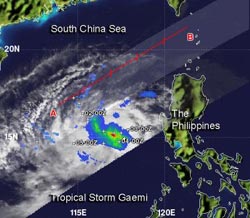NASA sees Tropical Storm Gaemi's heaviest rainfall around center

When NASA's TRMM satellite passed over Tropical Storm Gaemi on Oct. 3 at 1241 UTC (8:41 a.m. EDT), light rainfall (blue) was occurring over most of the storm. Moderate rain (green and orange) was falling at a rate between .78 to 1.57 inches/20 to 40 mm per hour and surrounded a small area of heavy rainfall (red) circling tightly around the center. The heaviest rain was falling at 2 inches (50 mm) per hour.<br><br>Credit: SSAI/NASA, Hal Pierce<br>
When NASA's Tropical Rainfall Measuring Mission (TRMM) satellite passed over Tropical Storm Gaemi on Oct. 3 at 1241 UTC (8:41 a.m. EDT), the precipitation radar instrument detected light rainfall occurring over most of the storm. Moderate rain was falling at a rate between .78 to 1.57 inches/20 to 40 mm per hour and surrounded a small area of heavy rainfall circling tightly around the around the center. The heaviest rain was falling at 2 inches (50 mm) per hour.
Satellite imagery on Oct. 4 shows that wind shear is taking a toll on the storm, pushing the bulk of the showers to the west, by strong easterly winds. The center of circulation also appears to be fully exposed to outside winds, which leaves the storm wide open for additional weakening influences.
On Tuesday, Oct. 3, 2012 at 1500 UTC (11 a.m. EDT), Tropical storm Gaemi had maximum sustained winds near 35 knots (40 mph/65 kph). It was located 605 nautical miles (696 miles/1,120 km) east of Hue, Vietnam near 14.7 North latitude and 117.7 East longitude. Gaemi was moving to the west at 2 knots (2.3 mph/3.7 kph).
Gaemi is expected to start moving around an area of high pressure nearby strengthens, which would push the storm west toward Vietnam. Gaemi is forecast to make landfall south of Hue, Vietnam sometime on Oct. 6. As the storm nears coastal conditions will deteriorate.
Media Contact
More Information:
http://www.nasa.govAll latest news from the category: Earth Sciences
Earth Sciences (also referred to as Geosciences), which deals with basic issues surrounding our planet, plays a vital role in the area of energy and raw materials supply.
Earth Sciences comprises subjects such as geology, geography, geological informatics, paleontology, mineralogy, petrography, crystallography, geophysics, geodesy, glaciology, cartography, photogrammetry, meteorology and seismology, early-warning systems, earthquake research and polar research.
Newest articles

Superradiant atoms could push the boundaries of how precisely time can be measured
Superradiant atoms can help us measure time more precisely than ever. In a new study, researchers from the University of Copenhagen present a new method for measuring the time interval,…

Ion thermoelectric conversion devices for near room temperature
The electrode sheet of the thermoelectric device consists of ionic hydrogel, which is sandwiched between the electrodes to form, and the Prussian blue on the electrode undergoes a redox reaction…

Zap Energy achieves 37-million-degree temperatures in a compact device
New publication reports record electron temperatures for a small-scale, sheared-flow-stabilized Z-pinch fusion device. In the nine decades since humans first produced fusion reactions, only a few fusion technologies have demonstrated…





















